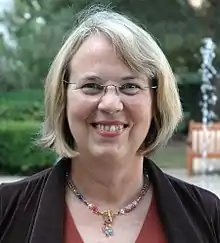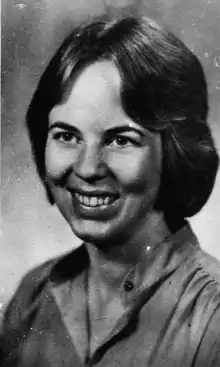
Mary Bernadette Kennedy (born 1947) is an American biochemist and neuroscientist. She is a member of the American Academy of Arts and Sciences, and is the Allen and Lenabelle Davis Professor of Biology at the California Institute of Technology, where she has been a member of the faculty since 1981. Her research focuses on the molecular mechanisms of synaptic plasticity, the process underlying formation of memory in the central nervous system. Her lab uses biochemical and molecular biological methods to study the protein machinery within a structure called the postsynaptic density. Kennedy has published over 100 papers with over 20,000 total citations.[1]
Biography

Kennedy was born on July 4, 1947, in Pontiac, in the US state of Michigan. Her family moved to South Bend, Indiana in 1953, where her father owned a shoe store, and her mother was a homemaker. She is the oldest of six siblings, with four sisters and a brother.[2]
Kennedy received a Bachelor of Science degree in chemistry in 1969 from St. Mary's College in South Bend. In 1975, she earned a Ph.D. in biochemistry from Johns Hopkins University in the laboratory of William Lennarz. She moved into the field of neuroscience during postdoctoral fellowships at Harvard Medical School with Edward Kravitz, and then at Yale University with Paul Greengard. In 1981, she moved to Caltech as an assistant professor and was promoted to professor in 1992. She was named Allen and Lenabelle Davis Professor of Biology in 2002.[3]
Major scientific contributions
Her laboratory purified and characterized the synaptic signaling protein Calcium/calmodulin-dependent protein kinase II (CaMKII) in 1983[4] and showed that it is 1-2% of forebrain protein,[5] is a major constituent of the postsynaptic density,[6] and is regulated by autophosphorylation following activation by synaptic activity.[7]
Her lab later used micro-sequencing, molecular cloning, and immunocytochemistry to identify the central PSD scaffold protein PSD-95 and its three repeated domains later termed PDZ domains.[8] With Peter Seeburg, they then showed that the second PDZ domain binds a terminal S-X-V motif at the carboxyl tail of GluN2B, an NMDA receptor subunit.[9] PDZ domains are now known to be ubiquitous in scaffold proteins where they immobilize other proteins by binding to their C-terminal ligands.[10] Her work was the first discovery of a PDZ domain and established that the PSD is a scaffold containing signaling enzymes and receptors that function as a molecular machine to regulate synaptic strength.[11][12]
Recent work concerns the role of the multifunctional PSD protein synGAP in regulating AMPA receptor insertion into the membrane[13] and trapping of AMPA receptors in the PSD.[14] She is collaborating with Tom Bartol and Terry Sejnowski at the Salk Institute to create kinetic models of biochemical signaling in postsynaptic spines.[15][16]
Honors and awards
- 1985 McKnight Neuroscience Investigator Award[17]
- 1991 Fellow of the American Association for the Advancement of Science
- 1991 Faculty Award for Women Scientists and Engineers (NSF)[18]
- 1992 Javits Neuroscience Investigator Award (NIH)
- 1999 Special Lecturer, Annual Meeting of the Society for Neuroscience
- 2002 Elected Fellow of the American Academy of Arts and Sciences[19]
- 2006 Fondation Ipsen Prize in Neuronal Plasticity[20]
References
- ↑ "Mary B. Kennedy". Google Scholar.
- ↑ Kennedy, M.B. (2018). Personal Communication
- ↑ "Mary B. Kennedy". Caltech Division of Biology and Biological Engineering. Archived from the original on 2018-08-11. Retrieved 2017-10-12.
- ↑ Bennett, M.K.; Erondu, N.E.; Kennedy, M.B. (1983). "Purification and characterization of a calmodulin-dependent protein kinase that is highly concentrated in brain". J Biol Chem. 258 (20): 12735–12744. doi:10.1016/S0021-9258(17)44239-6. PMID 6313675.
- ↑ Erondu, N.E.; Kennedy, M.B. (1985). "Regional distribution of type II Ca2+/calmodulin-dependent protein kinase in rat brain". J Neurosci. 5 (12): 3270–3277. doi:10.1523/JNEUROSCI.05-12-03270.1985. PMC 6565219. PMID 4078628.
- ↑ Kennedy, M.B.; Bennett, M.K.; Erondu, N.E. (1983). "Biochemical and immunochemical evidence that the "major postsynaptic density protein" is a subunit of a calmodulin-dependent protein kinase". Proc Natl Acad Sci USA. 80 (23): 7357–7361. Bibcode:1983PNAS...80.7357K. doi:10.1073/pnas.80.23.7357. PMC 390054. PMID 6580651.
- ↑ Miller, S.G.; Kennedy, M.B. (1986). "Regulation of brain type II Ca2+/calmodulin-dependent protein kinase by autophosphorylation: a Ca2+-triggered molecular switch". Cell. 44 (6): 861–870. doi:10.1016/0092-8674(86)90008-5. PMID 3006921. S2CID 491812.
- ↑ Cho, K.-O.; Hunt, C.A.; Kennedy, M.B. (1992). "The rat brain postsynaptic density fraction contains a homolog of the Drosophila discs-large tumor suppressor protein". Neuron. 9 (5): 929–942. doi:10.1016/0896-6273(92)90245-9. PMID 1419001. S2CID 28528759.
- ↑ Kornau, H.-C.; Schenker, L.T.; Kennedy, M.B.; Seeburg, P.H. (1995). "Domain interaction between NMDA receptor subunits and the postsynaptic density protein PSD-95". Science. 269 (5231): 1737–1740. Bibcode:1995Sci...269.1737K. doi:10.1126/science.7569905. PMID 7569905. ProQuest 213563617.
- ↑ Kornau, H.-C.; Seeburg, P.H.; Kennedy, M.B. (1997). "Interaction of ion channels and receptors with PDZ domain proteins". Curr Opin Neurobiol. 7 (3): 368–373. doi:10.1016/S0959-4388(97)80064-5. PMID 9232802. S2CID 24653335.
- ↑ Kennedy, M.B. (1997). "The postsynaptic density at glutamatergic synapses". Trends Neurosci. 20 (6): 264–268. doi:10.1016/S0166-2236(96)01033-8. PMID 9185308. S2CID 41855275.
- ↑ Kennedy, M.B. (2000). "Signal-processing machines at the postsynaptic density". Science. 290 (5492): 750–754. Bibcode:2000Sci...290..750K. doi:10.1126/science.290.5492.750. PMID 11052931.
- ↑ Walkup, W.G.t.; Washburn, L.; Sweredoski, M.J.; Carlisle, H.J.; Graham, R.L.; Hess, S.; Kennedy, M.B. (2015). "Phosphorylation of synaptic GTPase-activating protein (synGAP) by Ca2+/calmodulin-dependent protein kinase II (CaMKII) and cyclin-dependent kinase 5 (CDK5) alters the ratio of its GAP activity toward ras and rap GTPases". J Biol Chem. 290 (8): 4908–4927. doi:10.1074/jbc.M114.614420. PMC 4335230. PMID 25533468.
- ↑ Walkup, W.G.t.; Mastro, T.L.; Schenker, L.T.; Vielmetter, J.; Hu, R.; Iancu, A.; Reghunathan, M.; Bannon, B.D.; Kennedy, M.B. (2016). "A model for regulation by SynGAP-alpha1 of binding of synaptic proteins to PDZ-domain 'Slots' in the postsynaptic density". eLife. 5: e16813. doi:10.7554/eLife.16813. PMC 5040590. PMID 27623146.
- ↑ Stefan, M.I.; Bartol, T.M.; Sejnowski, T.J.; Kennedy, M.B. (2014). "Multi-state modeling of biomolecules". PLOS Comput Biol. 10 (9): e1003844. Bibcode:2014PLSCB..10E3844S. doi:10.1371/journal.pcbi.1003844. PMC 4201162. PMID 25254957.
- ↑ Bartol, T.M.; Keller, D.X.; Kinney, J.P.; Bajaj, C.L.; Harris, K.M.; Sejnowski, T.J.; Kennedy, M.B. (2015). "Computational reconstitution of spine calcium transients from individual proteins". Front Synaptic Neurosci. 07: 17. doi:10.3389/fnsyn.2015.00017. PMC 4595661. PMID 26500546.
- ↑ Strobel, Gabrielle, "Research Funding in Neuroscience: A Profile of the McKnight Endowment Fund", 2010, pg. 137, Academic Press
- ↑ California Institute of Technology Annual Report 1991-92, page 6
- ↑ "Mary B. Kennedy". The Kennedy Lab.
- ↑ "Neurosciences". Fondation Ipsen. Archived from the original on 2017-07-21. Retrieved 2017-10-14.
External links
- Kennedy lab web page at Caltech
- Kennedy faculty page at Caltech
- Robert Nelson and Shel Plotkin interview Mary B. Kennedy, Jeanne Nerbonne and Maureen Ockert (February 11, 1982). The Wizard show: Women in science (Radio broadcast). Los Angeles, California: KPFK.
- Lecture on Synaptic NanoMachines in 2008 at Neuroinformatics Meeting in Stockholm
- Lecture on Neural Plasticity at Caltech, 6/7/2011